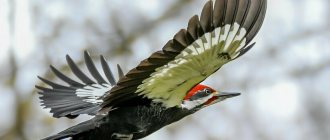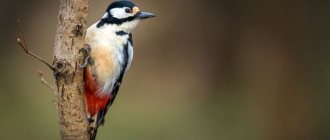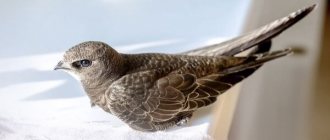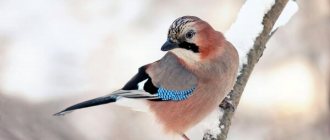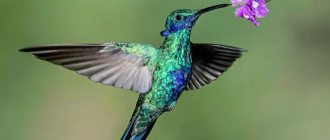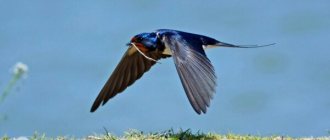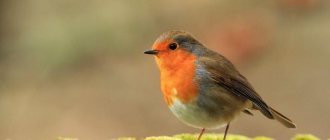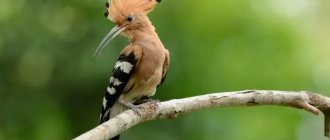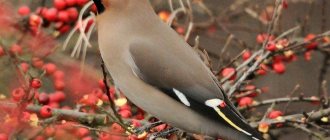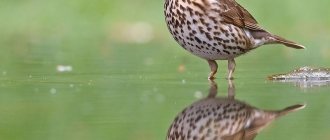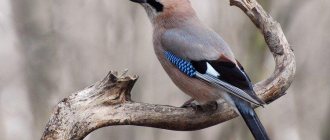Features and habitat of the woodpecker in nature
Since ancient times, everyone has been familiar with the sound of a forest shot being knocked out, to which you involuntarily listen and rejoice like a child: woodpecker ! In fairy tales, he is called a forest doctor and is endowed with the traits of a tireless worker, kind and persistent in establishing order and providing assistance. What is he really like?
Woodpecker family
The woodpecker family is huge and has settled almost all over the world, except Antarctica, Australia and several islands. It is difficult to count all their species: according to rough estimates, there are more than 200 living in large numbers, and the condition of others is little known, some are already recognized as extinct. There are 14 species of woodpecker birds in Russia.
Listen to the woodpecker's knock
The distribution area depends on the forest areas: the more extensive, the more woodpeckers will take root there. In every forest there are old rotten stumps and trunks, which means there will be work for woodpeckers. The bird thrives in both coniferous and deciduous forests.
The closest relatives of woodpeckers are toucans and honeyguides, exotic birds for Russia. Woodpeckers are quite defenseless, so the cause of death of woodpeckers is often attacks by hawks, snakes, martens, lynxes and other predators. Man also makes a bitter contribution by catching birds for various purposes. But woodpeckers are not considered game animals.
In the photo there is a small spotted woodpecker
Communicate with relatives
Woodpeckers are one of those birds that do not sing. Of course they have a voice. They can pronounce “kr-kr-kr”, “ki-ki-ki” and some other sounds that can be heard during the mating season. Woodpeckers also scream when a stranger from among their fellow tribesmen has entered their territory.
However, most often these birds give signals to each other by knocking. They beat the drum in different ways. It can be vibrating, dry, jerky, sharp. Typically a shot lasts 0.6 seconds and consists of 12 beats. You can hear it at a distance of up to 1.5 km from the bird.
Description of the woodpecker bird
Woodpeckers are unusually diverse in color plumage and vary significantly in size: from small ones, 8 cm long, to large ones, whose body reaches 60 cm. But there are a number of common signs that allow you to recognize a woodpecker in any clothing:
- Short four-toed legs, curved inward.
- Cone-shaped and strong beak.
- Rough, thin and very long thread-like tongue.
- Red spot on the head.
- Flexible and elastic tail with tail feathers.
The structure of the woodpecker is unusually connected with its main occupation - chiselling. The tail serves as a springy support, the feathers help to hold on, the beak is designed to destroy hard bark, and the tongue is designed to extract prey.
Woodpeckers always find a sick or rotten tree for a hollow.
The uniqueness of the bird is that its beak works like a jackhammer with a frequency of 10 blows per second. And the sticky tongue passing through the right nostril of the beak is capable of extending from 5 to 15 cm in different species of woodpeckers to extract insects from crevices. At the tip of the tongue there are sharp serrations on which prey is literally impaled. In the bird's head, the tongue wraps around the skull. The woodpecker breathes only through the left nostril.
Woodpecker lifestyle
Woodpeckers are sedentary birds, which can only be forced to nomadism by lack of food. But, having moved, they will no longer get ready for the return journey. They make short flights because of restlessness and a thirst to study every trunk. The woodpecker's flight has a wave-like character with a large amplitude of ups and downs.
They almost never go down to the ground; they feel awkward, not being adapted to being horizontal. They live alone, without forming colonies. Woodpeckers do not make friends with other forest songbirds; occasionally they can be seen among their relatives due to meetings at abundant feeding areas.
A woodpecker hammers a tree up to 10 times per second.
Birds spend most of their time studying trees. Flying to another trunk, the woodpecker sits at the bottom, and then jumps up in a spiral way. It almost never sits on branches and horizontal branches, it never descends upside down, the bird’s movement is directed upward or to the side, this is facilitated by the plumage of the tail, which works like a spring.
The familiar pose of a woodpecker sitting on a tree is preserved even at night, when it also hangs in a hollow on a vertical surface and sleeps. All woodpeckers make hollows, but the period of their creation is different. Typically it takes two weeks, although there are examples of cockaded woodpeckers constructing a cavity over several years.
The choice of wood is related to the nature of the wood: choose soft, heart-shaped wood, like aspen. Many woodpeckers change apartments in the new year, and leave the old ones to owls, goldeneyes and other homeless inhabitants.
In the photo there is a green woodpecker
The woodpecker is a noisy and noisy bird; it not only creates loud sounds by chiseling, but also vibrates twigs and branches, the cracking of which can be heard up to one and a half kilometers. own song is a short and frequent trill.
Listen to the woodpecker's trills
2. Woodpeckers live everywhere, of course, except Antarctica. And woodpeckers cannot be found in Australia, on the island of Madagascar and in New Zealand.
3. These birds have a very wide habitat, but mostly they live in wooded areas.
4. In total, there are about 220 species of woodpeckers, the sizes of which vary from 15 to 53 centimeters.
5. The most common plumage colors are black, white, red and yellow. Some species of woodpeckers are orange, green, brown, maroon and gold.
downy woodpecker
6. The downy woodpecker is a species that is more common in North America. There are about two dozen such woodpeckers found in the United States.
7. Woodpeckers move along a tree trunk from bottom to top, helping themselves with the claws on their paws and their tail. By the way, the tail bears the main load, which is why it decreases by about one tenth over the course of a year.
8. A woodpecker is capable of striking a tree at a speed of 20–25 times per second (which is almost twice the speed of a machine gun) 8000–12000 times a day!
9. Most woodpeckers have zygodactyl feet. This means 3 fingers point forward and one finger points back. This shape helps woodpeckers grab onto a tree trunk and stay upright. They use this fourth finger and stiff tail feathers to hold themselves on the tree as they climb.
10. A woodpecker's tongue can reach a size of 4 inches (10 cm) in length. It depends on the species of woodpecker. Its tongue can curl around its skull. Many woodpeckers have barbed tongues, which they use to extract beetles and insects from trees and wormholes.
European woodpecker
11. European woodpeckers, in addition to beetles and larvae, are also big fans of cherries and sweet (not sour) cherries. They happily raid from the forest to orchards and summer cottages.
12. Due to huge energy consumption, the woodpecker is constantly hungry. For example, the black woodpecker (native to North America) can eat 900 beetle larvae or 1,000 ants in one sitting; The green woodpecker eats up to 2,000 ants per day.
13. This truly ravenous appetite has a purpose: woodpeckers play an important role in insect control and help limit the spread of tree diseases by eliminating disease vectors. Thus, the woodpecker bird helps preserve forests.
White-backed Woodpecker
14. Woodpeckers, in addition to everything else, have a cerebellum that is designed in such a way that it will never have a concussion.
15. When this bird strikes a tree, it uses incredible force. If the same force were applied to the skull of any other bird, its brain would quickly turn to mush. Moreover, if a person hit his head on a tree with the same force, he, even if he survived the concussion, would have suffered a very serious brain injury.
Royal woodpeckers
16. The largest species of this family of birds is the royal woodpecker. Its length reaches more than half a meter.
17. The two largest woodpeckers in the world: the American king woodpecker and the ivory-billed woodpecker. Unfortunately, these two species are vulnerable to extinction.
18. Native Americans used the beak of the Ivory-billed Woodpecker as an ornament. They traded them all over North America.
19.The largest woodpecker that has been discovered in Southeast Asia is called the Great Müllerian Woodpecker. It is 20 inches (50 cm) long.
20. The golden-fronted melanerpes turns itself purple in the summer. This is because this species of woodpecker eats the fruit of the common prickly pear (a type of cactus).
Pygmy Woodpecker
21. Pygmy woodpeckers are a species of woodpeckers that are found in South America and Asia. These woodpeckers are the smallest. They are only 3-4 inches (8-10 cm) long, depending on the species.
22. When a woodpecker drums on a tree at a speed of up to 22 times per second, its head experiences overloads reaching 1000 g (a person would be “knocked out” already at 80–100 g).
Syrian woodpecker
23.During “drilling operations,” the woodpecker’s head moves at a speed more than twice the speed of a bullet when fired.
24. When a woodpecker knocks on a tree at a speed of up to 20 times per second, its eyelids close each time an instant before the moment its beak approaches its target. This is a kind of mechanism for protecting the eyes from splinters. Closed eyelids also hold the eyes in place and prevent them from flying out.
25. The Crested Woodpecker is the largest woodpecker in North America.
Acorn Woodpecker
26. The acorn woodpecker, which is very thrifty by nature, lives in North America. So, in preparation for winter, he lays about 400 acorns, one at a time in the holes of different trees.
27. The Great Spotted Woodpecker is the most numerous and widespread species in Europe.
28.This species can also be found from southern Spain to northern Scandinavia.
29. Woodpeckers eat beetles, insects, fruits, nuts, seeds, and they also drink plant sap. Woodpeckers are also attracted to kidney and nut fat.
30. There are no species of woodpeckers in Ireland, and seeing a Great Spotted Woodpecker there is also rare. These woodpeckers are not regular visitors to this area.
Woodpecker - sucker
31. One of the representatives of this bird family, the sucking woodpecker, feeds exclusively on sweet nectar. He makes a hole in the tree bark before the sap begins to flow from it.
32. Woodpeckers do not sing, but instead they knock on various objects (hollow, rotten wood, power poles, chimneys, gutters, garbage cans), making the sound of drumming.
32. Woodpeckers knock to attract a partner, to mark territory and for communication. As is known, individuals of both sexes are capable of knocking.
33. While foraging for food by extracting it from trees and tapping, woodpeckers can tap more than 20 times per second. In total, the woodpecker knocks 8,000-12,000 times a day.
34. The first tapping of woodpeckers usually begins in early January and continues until June.
35. Although insects are the main food of woodpeckers, tree seeds also serve as additional food.
Great Spotted Woodpecker
36. The Great Spotted Woodpecker is not content with larvae and insects; it often feeds on the eggs of other birds and even already hatched chicks.
37. It is very easy to determine the sex of a woodpecker. Only male woodpeckers have a scarlet back of the neck.
38. Individuals of both sexes hatch eggs. 12 days are enough for the chicks of these birds to hatch.
39. At first, the parents care and look after the cubs. For 10 days after the chicks leave the nest, the parents feed them. Every day the chicks become stronger and more independent.
40. Juveniles are easily recognizable due to their red cap. They lose this cap when their plumage is updated to a more mature one.
41. These birds nest in hollows. To do this, they can use not only an existing hollow, but can also easily knock out a new one.
42. Nests that woodpeckers have made for themselves are most often used for several seasons.
43. The reason for the recent sharp decline in the number of lesser spotted woodpeckers may be the fight and extermination of woodpeckers by predators.
44. Migrating Great Spotted Woodpeckers from northern Europe sometimes reach Britain. This often happens in the fall. They are quite large in size and their body is white.
45. In the UK, woodpeckers have been seen expanding their range over the last century, following a sudden and unexplained decline 200 years ago.
46. Many people think that woodpeckers knock on wood exclusively in search of food. In fact, they also do this in order to claim their territory, as well as in search of a mate.
47. Inexperienced and young woodpeckers often crash into windows. This is one of the main causes of death in young birds.
48. In 1995, these cute birds caused irreparable damage to NASA. They made a huge number of holes in the fuel tank of the Discovery shuttle, thereby delaying the launch for the next couple of months.
49. The most dire threats to the woodpecker include habitat loss due to development and urban sprawl, the use of insecticides that destroy food sources, and natural disasters such as forest fires that destroy dry forests. These threats create a huge barrier to woodpeckers' foraging and nesting.
50. The average lifespan of a wild woodpecker can last from 4 to 11 years, depending on the type of woodpecker.
Northern woodpecker
photo from the Internet
Woodpecker feeding
The main food in the warm season consists of woodworms: insects, their larvae, termites, ants, aphids. It is interesting that the woodpecker obtains food only from diseased and rotten plants, without touching healthy trees.
But simple gathering is not alien to it, so berries and plant seeds occupy a significant place in the diet; the woodpecker preys on snails, small passerine birds, their eggs and chicks.
In winter, the main diet consists of seeds and nuts obtained from the cones of coniferous plants. The woodpecker creates entire forges by placing cones in crevices and breaking them with his beak. In the forest you can find mountains of husks from such work. Sometimes creates storage rooms. In frosty weather, birds can approach cities, feeding on food waste and carrion.
Instead of water in winter, the woodpecker swallows snow, and in spring it likes to extract birch or maple sap by breaking through the bark of trees. Buds and young shoots of plants also become food.
They are building a house
Woodpeckers hatch their chicks in a hollow. Most often, they build a new home every year. However, cases have been recorded of woodpeckers using the same hollow for several years.
During the construction process, the sound of the bird's beak can be heard from morning to evening. Sometimes woodpeckers stumble upon internal branches. Then they abandon the hollow they started and start a new one. The work takes at least 2 weeks. The finished dwelling has a depth of up to 35 cm. The diameter of the hollow is 11-12 cm. Imagine how much wood he needs to hollow out.
Woodpecker reproduction and lifespan
The mating season of woodpeckers begins in the spring. Having decided on the choice of a pair, the birds build a nesting hollow. They work in turns, lining the bottom with wood chips. To protect the offspring from predators, they make two very small entrances and camouflage them with branches, and sometimes they immediately place their shelter under a tree tinder fungus.
3-7 white eggs are hatched in turn, and after 15 days the first chicks begin to appear. Their appearance is completely helpless: naked, blind, deaf. But after about a month, the fledgling inheritance squeals so much that it is not difficult for hunters to find them. Having not yet learned to fly, they are already running along the trunk.
Pictured is a woodpecker chick
A year later, sexual maturity sets in, but already in the first winter, the parents mercilessly drive away the young, since it is easier for woodpeckers to feed themselves one at a time. Woodpeckers of different species live in natural conditions from about 5 to 11 years.
They are building a house
Woodpeckers hatch their chicks in a hollow. Most often, they build a new home every year. However, cases have been recorded of woodpeckers using the same hollow for several years.
During the construction process, the sound of the bird's beak can be heard from morning to evening. Sometimes woodpeckers stumble upon internal branches. Then they abandon the hollow they started and start a new one. The work takes at least 2 weeks. The finished dwelling has a depth of up to 35 cm. The diameter of the hollow is 11-12 cm. Imagine how much wood he needs to hollow out.
Woodpeckers in Russia
Representatives of different species of woodpeckers live in the forests of Russia, among which the most common are
- black or yellow,
- big motley,
- small motley,
- three-fingered gray-haired
- green.
The black one is the largest woodpecker , weighing up to 300 grams, among the woodpecker inhabitants of our country. It differs from others by its oval entrance to a spacious hollow. Another special feature is a long and loud trill, which is considered a call to relatives.
In the photo there is a black woodpecker bird
The Greater and Lesser Spotted Woodpecker are some of the most beautiful species. Greater motley is often found in park areas and city limits. Small, the size of a sparrow, lives in the Caucasus, and Primorye, on Sakhalin. It is considered the most playful and agile.
Pictured is a Great Spotted Woodpecker
The three-toed gray woodpecker is a resident of northern coniferous forests. He is very voracious: in a day he can peel off a tall spruce to get bark beetles. The name refers to the missing front finger. The green woodpecker, unlike its relatives, runs well on the ground in search of worms and caterpillars. He loves ant eggs, which is why he digs holes in anthills.
Pictured is a three-toed gray woodpecker
Communicate with relatives
Woodpeckers are one of those birds that do not sing. Of course they have a voice. They can pronounce “kr-kr-kr”, “ki-ki-ki” and some other sounds that can be heard during the mating season. Woodpeckers also scream when a stranger from among their fellow tribesmen has entered their territory.
However, most often these birds give signals to each other by knocking. They beat the drum in different ways. It can be vibrating, dry, jerky, sharp. Typically a shot lasts 0.6 seconds and consists of 12 beats. You can hear it at a distance of up to 1.5 km from the bird.
Keeping a woodpecker in captivity
The birds' bright plumage and activity make them targets for captivity. about the woodpecker at home that it is easily tamed, even flies to its name, but to create conditions for the bird, you need spacious enclosures with tree trunks.
Communication with birds requires caution, as they can injure with a blow from their beak. If you manage to create an artificial corner of the forest for a woodpecker, then it will certainly become a favorite, communication with which will bring many pleasant moments.
